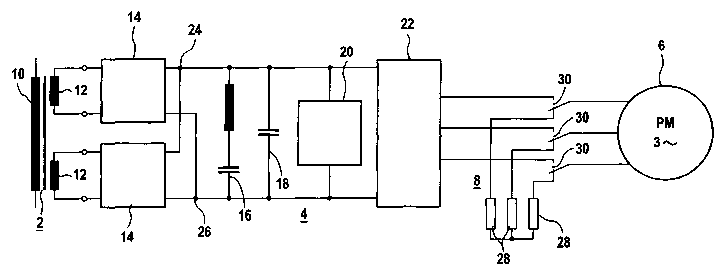Some of the information on this Web page has been provided by external sources. The Government of Canada is not responsible for the accuracy, reliability or currency of the information supplied by external sources. Users wishing to rely upon this information should consult directly with the source of the information. Content provided by external sources is not subject to official languages, privacy and accessibility requirements.
Any discrepancies in the text and image of the Claims and Abstract are due to differing posting times. Text of the Claims and Abstract are posted:
| (12) Patent Application: | (11) CA 2470349 |
|---|---|
| (54) English Title: | TRACTION DRIVE |
| (54) French Title: | ENTRAINEMENT DE TRACTION |
| Status: | Deemed Abandoned and Beyond the Period of Reinstatement - Pending Response to Notice of Disregarded Communication |
| (51) International Patent Classification (IPC): |
|
|---|---|
| (72) Inventors : |
|
| (73) Owners : |
|
| (71) Applicants : |
|
| (74) Agent: | SMART & BIGGAR LP |
| (74) Associate agent: | |
| (45) Issued: | |
| (86) PCT Filing Date: | 2002-11-28 |
| (87) Open to Public Inspection: | 2003-06-19 |
| Examination requested: | 2004-06-09 |
| Availability of licence: | N/A |
| Dedicated to the Public: | N/A |
| (25) Language of filing: | English |
| Patent Cooperation Treaty (PCT): | Yes |
|---|---|
| (86) PCT Filing Number: | PCT/DE2002/004380 |
| (87) International Publication Number: | WO 2003050940 |
| (85) National Entry: | 2004-06-09 |
| (30) Application Priority Data: | ||||||
|---|---|---|---|---|---|---|
|
The invention relates to a traction drive comprising a traction power
converter (4) and a permanent-field synchronous motor (6), said traction power
converter (4) comprising at least one pulsed power converter (22) on the
machine side. According to the invention, the permanent-field synchronous
motor (6) is respectively connected to an input of a commutator (30) on the
terminal side, the outputs of said commutator being respectively connected to
an output of the pulsed power converter (22) and to a connection of the star-
connected braking resistances (28). In this way, a fail-safe electrical brake
which is independent from the power inverter can be obtained for a set of
traction wheels of a rail vehicle, such that a mechanical brake is not
required.
L'invention concerne un entraînement de traction comportant un convertisseur de courant statique de traction (4) et un moteur synchrone à excitation permanente (6), ledit convertisseur de courant statique de traction (4) présentant côté machine au moins un convertisseur de courant pulsé (22). Selon l'invention, le moteur synchrone à excitation permanente (6) est raccordé côté bornes à une entrée d'un commutateur (30) dont les sorties sont raccordées respectivement à une sortie du convertisseur de courant pulsé (22) et à une borne de résistances de freinage (28) montées en étoile. Ainsi, il est possible de mettre en oeuvre un frein électrique fiable indépendant de l'onduleur, destiné à un essieu moteur d'un véhicule sur rails, de façon à s'affranchir totalement d'un frein mécanique.
Note: Claims are shown in the official language in which they were submitted.
Note: Descriptions are shown in the official language in which they were submitted.

2024-08-01:As part of the Next Generation Patents (NGP) transition, the Canadian Patents Database (CPD) now contains a more detailed Event History, which replicates the Event Log of our new back-office solution.
Please note that "Inactive:" events refers to events no longer in use in our new back-office solution.
For a clearer understanding of the status of the application/patent presented on this page, the site Disclaimer , as well as the definitions for Patent , Event History , Maintenance Fee and Payment History should be consulted.
| Description | Date |
|---|---|
| Application Not Reinstated by Deadline | 2009-04-27 |
| Inactive: Dead - No reply to s.30(2) Rules requisition | 2009-04-27 |
| Deemed Abandoned - Failure to Respond to Maintenance Fee Notice | 2008-11-28 |
| Inactive: Abandoned - No reply to s.30(2) Rules requisition | 2008-04-25 |
| Inactive: S.30(2) Rules - Examiner requisition | 2007-10-25 |
| Letter Sent | 2004-09-28 |
| Inactive: Courtesy letter - Evidence | 2004-09-21 |
| Inactive: Cover page published | 2004-09-21 |
| Letter Sent | 2004-09-17 |
| Inactive: Acknowledgment of national entry - RFE | 2004-09-17 |
| Application Received - PCT | 2004-07-14 |
| Inactive: Single transfer | 2004-06-23 |
| Request for Examination Requirements Determined Compliant | 2004-06-09 |
| All Requirements for Examination Determined Compliant | 2004-06-09 |
| National Entry Requirements Determined Compliant | 2004-06-09 |
| Application Published (Open to Public Inspection) | 2003-06-19 |
| Abandonment Date | Reason | Reinstatement Date |
|---|---|---|
| 2008-11-28 |
The last payment was received on 2007-10-16
Note : If the full payment has not been received on or before the date indicated, a further fee may be required which may be one of the following
Please refer to the CIPO Patent Fees web page to see all current fee amounts.
| Fee Type | Anniversary Year | Due Date | Paid Date |
|---|---|---|---|
| Basic national fee - standard | 2004-06-09 | ||
| Request for examination - standard | 2004-06-09 | ||
| Registration of a document | 2004-06-23 | ||
| MF (application, 2nd anniv.) - standard | 02 | 2004-11-29 | 2004-10-18 |
| MF (application, 3rd anniv.) - standard | 03 | 2005-11-28 | 2005-10-14 |
| MF (application, 4th anniv.) - standard | 04 | 2006-11-28 | 2006-10-13 |
| MF (application, 5th anniv.) - standard | 05 | 2007-11-28 | 2007-10-16 |
Note: Records showing the ownership history in alphabetical order.
| Current Owners on Record |
|---|
| SIEMENS AKTIENGESELLSCHAFT |
| Past Owners on Record |
|---|
| ANDREAS JOECKEL |